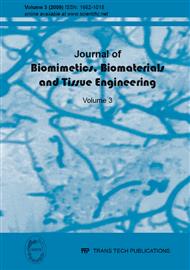[1]
Y. C. Fung: Biomechanics: mechanical properties of living tissues (Springer Verlag, New York 1981).
Google Scholar
[2]
J. E. Gordon: The Science of Structures and Materials (W.H. Freeman and Co., New York 1988).
Google Scholar
[3]
R. Lakes: Nature Vol. 361 (1993), p.511.
Google Scholar
[4]
C. Edwards and R. Marks: Clin. Dermatol. Vol. 13 (1995), p.375.
Google Scholar
[5]
R. Reihsner, B. Balogh and E. J. Menzel: Med. Eng. Phys. Vol. 17 (1995) p.304.
Google Scholar
[6]
J. A. Clark, J. C. Y. Cheng and K. S. Leung: Burns Vol. 22 (1996), p.443.
Google Scholar
[7]
Y. Lanir: J. Biomech. Vol. 12 (1979), p.423.
Google Scholar
[8]
Y. Lanir: J. Biomech. Vol. 16, (1983), p.1.
Google Scholar
[9]
G. Limbert and M. Taylor: Int. J. Solids Struct. Vol. 39 (2002), p.2343.
Google Scholar
[10]
J. C. Simo and R. L. Taylor: Comput. Methods Appl. Mech. Eng. Vol. 85 (1991), p.273.
Google Scholar
[11]
J. A. Weiss, B. N. Maker and S. Govindjee: Comput. Methods Appl. Mech. Eng. Vol. 135 (1995), p.107.
Google Scholar
[12]
G. A. Holzapfel, R. Eberlein, P. Wriggers and H. W. Weizs¨acker: Comput. Methods Appl. Mech. Eng. Vol. 132 (1996), p.45.
Google Scholar
[13]
J. E. Bischoff, E. M. Arruda and K. Grosh: J. Biomech. Vol. 33 (1999), p.645.
Google Scholar
[14]
T. C. Gasser and G. A. Holzapfel: Comput. Mech. Vol. 29 (2002), p.340.
Google Scholar
[15]
T. A. L. Wren and D. R. Carter: J. Biomech. Eng. Vol. 120 (1998), p.55.
Google Scholar
[16]
A. J. M. Spencer: in A. J. M. Spencer (editor) Continuum theory of the mechanics of fibrereinforced composites, p.1 (Springer Verlag, Wien-New York 1984).
Google Scholar
[17]
G. A. Holzapfel: Nonlinear solid mechanics (John Wiley and Sons, Chichester, 2000).
Google Scholar
[18]
M. Kojic, S. Mijailovic and N. Zdravkovic. Comput. Mech. Vol. 21 (1998), p.189.
Google Scholar
[19]
M.K. Kwan and S. L-Y Woo: ASME J. Biomech. Eng. Vol. 111 (1989), p.361.
Google Scholar
[20]
J.A. Weiss: A constitutive and finite element representation for transversely isotropic soft tissues (PhD thesis, University of Utah, Department of Bioengineering, 1994).
Google Scholar
[21]
C. Hurschler, B. Loitz-Ramage and R. Vanderby Jr.: ASME J. Biomech. Eng. Vol. 119 (1997), p.392.
Google Scholar
[22]
M. Abramowitz and I. A. Stegun: Handbook of mathematical functions (Dover Publications, New York, 1965).
Google Scholar
[23]
R. W. Ogden: Non-linear elastic deformations (Dover Publications, Mineola, NY, second edition, 1997).
Google Scholar
[24]
T. Belytschko, W. K. Liu and B. Moran: Nonlinear finite elements for continua and structures (John Wiley and Sons, Chichester, 2000).
Google Scholar
[25]
F. Gruttmann and R. L. Taylor. Int. J. Numer. Methods Eng. Vol. 35 (1992), p.1111.
Google Scholar
[26]
J. Bonet and R. D. Wood. Nonlinear continuum mechanics for finite element analysis (Cambridge University Press, Cambridge, UK, 1997).
Google Scholar
[27]
Adina R&D: User-supplied options manual (Adina R&D, 1999).
Google Scholar
[28]
K-J. Bathe: Finite element procedures (Prentice Hall, Upper Saddle River, NJ, 1996).
Google Scholar
[29]
G. N. Savin: Stress concentration around holes (Pergamon Press, Oxford, 1961).
Google Scholar
[30]
A. E. Green and W. Zerna: Theoretical elasticity (Dover Publications, Mineola, NY, second edition, 1992).
Google Scholar


